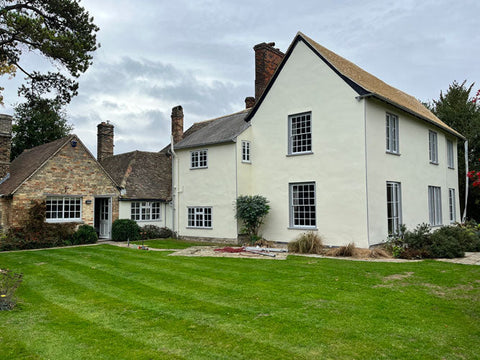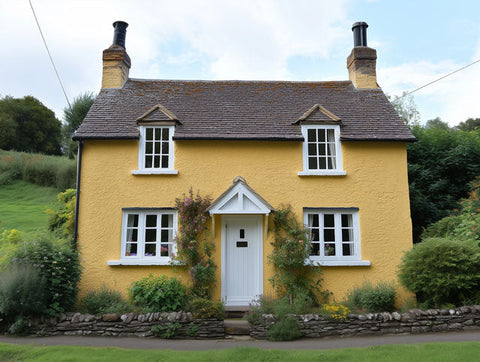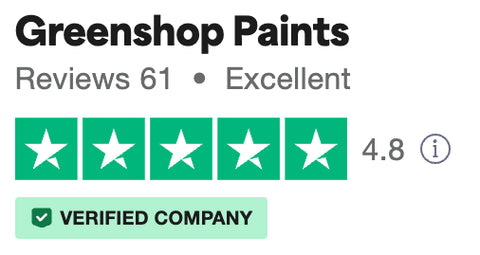Are you thinking of painting your old house and want to understand the best paint types to use? Clay paint is a highly breathable finish which won’t trap moisture or damage traditional substrates like lime plaster.
Made from natural ingredients including clay and mineral pigments, this type of paint offers a uniquely beautiful texture, a soft matt finish, and is available in a wide range of colours. If you want to stay true to period colours or soft heritage tones, an appropriate clay paint shade will be available.

Pictured: Auro 535 Champagne Clay Paint.
Whether you’re restoring a Victorian Hallway, or Updating a Georgian parlour - clay paint will work with the traditional materials in your home. It’s also suitable for use over gypsum based plasters, and modern paints.
In this guide for period home renovators we’ll explore:-
- Why clay paint is a great choice for solid walls of traditional construction.
- The compatibility of clay paint with lime plastered surfaces.
- Which surfaces are suitable for a clay paint finish.
- How to apply clay paint, and what the finish looks like.
- Other breathable paint types you may wish to consider.
A Brief History of Clay Paint
Clay paint has been used to decorate homes for over 500 years. Early civilisations such as the Egyptians and Mesopotamanians used the finish combined with colour pigments as a natural, breathable way to decorate interior walls.
Its traditional clay and mineral ingredients have found new relevance today, offering eco conscious homeowners a safe, sustainable alternative that’s free from plastic, chemicals and emissions.
It’s effectively VOC free, and completely in tune with the needs of heritage properties.
What is Clay Paint?
Clay paint is a highly breathable, natural water based emulsion. It’s primary ingredients are clay, mineral fillers, and plant based or mineral binders. Differing from modern plastic paints, clay paints are free from acrylics and vinyls, allowing them to breathe naturally.
Auro 331 (white), Auro 535 (coloured), and Earthborn Claypaint are modern formulations that preserve traditional breathable qualities while offering improved ease of use and eco credentials.
Earthborn Claypaint, for example, is made from natural clays, chalk, kaolin, and vinegar ester, with virtually no VOCs and no odour. It's certified under the EU Ecolabel, is EN71-3 (meaning it is a child friendly and baby safe paint), and contains no acrylics or oils.
This makes it particularly suitable for allergy sensitive households and for painting heritage properties where breathable finishes are essential.
Suitable Substrates for Clay Paint
Clay paint can be used on many interior surfaces common in older homes and period properties, including:-
- Lime plaster & gypsum plaster
- Gypsum boards & plasterboard
- Brick and concrete
- Wallpaper
- Existing paints, breathable or not
A Note About Clay Paint & Lime Plaster
Lime plaster has a high PH value. This can occasionally affect pigments, leading to slight colour variation. We recommend using a tester pot to check colour suitability first.
See also: Painting over lime plaster.
Breathability and Moisture Management
A defining feature of clay paint is its exceptional breathability.
Auro 331 and Auro 535 both offer SD values of < 0.015 m, placing them in SD Class 1 - the most breathable classification.
Earthborn Claypaint has an SD value of 0.02 m, which also qualifies as SD Class 1, meaning it allows a high level of vapour permeability.
This means water vapour can pass through these paints without much resistance at all, which is a good thing. For homes with solid walls, this prevents trapped moisture, which can cause mould, flaking, or structural damage.
Clay paints also help regulate indoor humidity by absorbing and releasing moisture - ideal for bedrooms, living areas, and anywhere a comfortable, healthy environment is desired.
Health and Environmental Benefits of Clay Paint
One of the biggest advantages of clay paint is its natural formulation, which makes it an excellent choice for health conscious decorators and eco friendly homes.
Vegan friendly: Clay paints are formulated without animal derived ingredients, making them suitable for vegan households.
Baby safe and odour free: With virtually no VOCs and no strong smells, clay paint is safe for use in nurseries and homes with small children.
Allergy and asthma friendly: Free from acrylics, oils, and high VOCs, clay paints are naturally antistatic and help minimise dust and allergens in the air.
Because they’re made from breathable, mineral based materials, clay paints support healthy indoor air quality while offering a soft, non toxic finish.
Period Homes That Benefit from Clay Paint
Using natural, breathable paints like clay paint helps preserve the historic integrity of period properties and listed buildings while meeting modern environmental and health standards.
Clay paint is particularly suited to:-
- Georgian and Regency homes with lime plastered walls.
- Victorian terraces with solid brickwork.
- Rural cottages with stone or cob walls.
- Arts and Crafts era interiors, often featuring natural materials.
In all these cases, clay paint supports the breathability of the wall system while offering a finish that’s soft, traditional, and authentic.
What Does Clay Paint Finish Look Like?
Clay paint creates a beautifully soft, ultra matt finish that feels velvety to the touch and gently diffuses light.
This makes it particularly well suited to heritage interiors where you want a natural, matt look that complements plasterwork and period detailing.
Unlike plastic paints that can appear flat or artificial, clay paint has a depth and richness that subtly enhances walls, whether you’re using white or one of the many coloured options available.
Because it absorbs and reflects light differently depending on the time of day and surface texture, clay paint gives rooms a calm, nuanced feel that evolves throughout the day.
What Other Natural Breathable Paints Are Available?
In addition to clay paint, there are several other types of breathable paints suitable for old houses:
Limewash - a traditional, ultra-breathable finish made from lime and water, ideal for bare masonry and lime plaster.
Lime paint - highly breathable, with lime as a primary ingredient. Lime paint has natural anti mould properties making it suitable for areas where mould is a particular issue. Dries to a distinctive and attractive matte appearance.
Casein paint - made from milk protein and lime, casein paint is durable, breathable, and excellent for interior walls and woodwork.
Each of these paints allows moisture to evaporate naturally, helping protect the structure and breathability of heritage properties
Clay Paint Colour Options
Clay paints are available in an impressively wide range of attractive colours suitable for heritage interiors:
Auro No. 331: A white-only, ultra-breathable option for simple, traditional applications.
Auro No. 535: Comes in 96 machine-mixed colours including popular choices like Olive Green, Cream, Teal, Forest Green, Champagne, and Steel.
Earthborn Claypaint: Offers 72 standard colours, including titanium dioxide-free options such as Marbles, Freckle, Humpty Dumpty, and Flower Pot. It has an ultra matt finish and is ideal for sensitive environments due to its low VOC content and allergy-friendly formulation.
Roman Clay: How It Differs from Clay Paint
Roman clay is not a paint product. Rather, it’s a decorative plaster type finish that is applied using a trowel in thin, layered coats. It creates a smooth, stone-like surface with a soft sheen and tactile texture. It’s a niche choice for home decorators, and takes a reasonable amount of expertise to apply.
Clay paint, by contrast, is rolled or brushed on and dries to an ultra matt, velvety finish. Its breathable nature makes it ideal for traditional materials like lime plaster and solid walls, helping regulate moisture and preserve the integrity of old buildings.
Frequently Asked Questions
Is clay paint mould resistant?
Clay paints are slightly more mould inhibiting than ordinary paints, due to high levels of breathability and humidity regulating properties. But if you have areas in your home where mould is an issue, then our range of natural anti mould paints are also suitable for period properties, highly breathable, and naturally mould resistant.
Clay Paint & Old Houses - A Perfect Match
Clay paint is a perfect match for old houses. It respects the building’s natural moisture balance, enhances indoor comfort, and provides a beautifully soft, traditional finish. Whether you're refreshing an Edwardian bedroom or updating a cottage kitchen, clay paint offers a sustainable, breathable solution that’s compatible with the very fabric of heritage homes.
Do please consider ordering one of our free paint charts, or very reasonably priced paint colour swatches which you can stick to the wall, and reuse as many times as you like. You can also browse our range of paint colours by shade.





